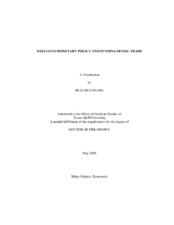| dc.description.abstract | The dissertation consists of three essays. Chapter II examines the asymmetric
effects of monetary policy on stock prices by using an unobserved components model
with Markov-switching. My results show that monetary policy has negative effects on
stock prices, which is consistent with the most recent literature. When the transitory
component is in the low volatility state, a contractionary monetary policy significantly
reduces stock prices. When the transitory component is in the high volatility state, the
negative effect of monetary policy becomes larger, but the difference of the monetary
policy effects between two states is not significant. Besides, a contractionary monetary
policy will lower the probability of stock prices staying in the low volatility state.
Monetary policy also reduces the total volatility of stock prices and the volatility of the
transitory component of stock prices.
Chapter III employs the smooth transition autoregressive (STAR) models to
investigate the nonlinear effect of monetary policy on stock returns. The change in the
Federal funds rate is used as an endogenous measure of monetary policy and the growth
rate of industrial production is also considered in the model. My empirical results show that excess stock returns, the change in the Federal funds rate, and the growth rate of
industrial production all can be expressed in the nonlinear STAR models. The estimated
coefficients and the impulse response functions show that the effect of monetary policy
on excess returns of stock prices is significantly negative and nonlinear. The change in
the Federal funds rate has a larger negative effect on excess returns in the extreme low
excess returns regime and the effect becomes smaller when the excess returns are greater
than the threshold value.
In chapter IV, I use a panel data approach to investigate the impact of exchange
rate volatility on bilateral exports of the U.S. to the thirteen major trading partners. I
further test the possibility of nonlinear effects of exchange rate volatility on exports by
using threshold regression methods for non-dynamic panels with individual-specific
fixed effects proposed by Hansen (1999). The results indicate that the effect of exchange
rate volatility on bilateral exports is nonlinear. When the relative real GDP per capita of
the exporting partner is lower than the threshold value, the response of bilateral U.S.
exports to exchange rate volatility is positive. But, exchange rate volatility decreases
bilateral exports of the U.S. to the exporting partners when their relative real GDP per
capita surpass the threshold value. | en |


